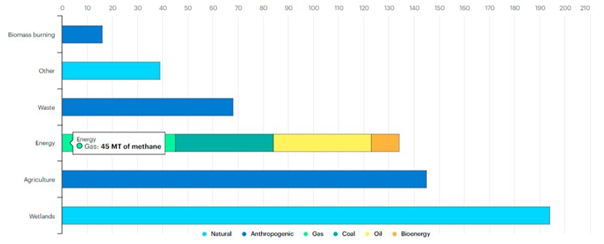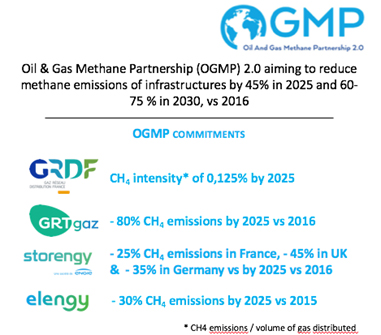 |
Fugitive natural gas emissions (mainly methane) from the gas infrastructures controlled and operated by ENGIE are one of the sources of the Group's greenhouse gas (GHG) emissions.
They are the primary source of direct GHG emissions for the Group's activities as operator of distribution networks, storage facilities or LNG terminals, and the second largest source for its activities as operator of transmission networks, just after the emissions linked to the consumption of gas as the driving force of the transmission network.
Methane releases generally occur during operations or maintenance (e.g. venting of a pressure-reducing station), venting the gas is a safety procedure for gas infrastructures operation and then vented emissions may be the results of testing this procedure or real implementation of this procedure in case of danger1. More rarely during commissioning or shutdown operations (e.g. purging of a pipeline), and very exceptionally during operating incidents (e.g. following damage to a pipeline caused by the work of a third-party operator). The other minor sources of GHG emissions from gas infrastructure operators are direct emissions from the entities' vehicle fleets (Scope 1), indirect emissions linked to energy consumption in buildings (Scope 2) and those linked to purchases of goods and services (Scope 3).
ENGIE's commitments
ENGIE has been committed for several years to reducing its emissions and today, thanks to these efforts, the group's CH4 emissions are 1.57 Mt CO2 eq in 2021, which represents less than 1% of the Group's total balance of 166 Mt CO2 eq.
This voluntary commitment has been translated into commitments at the entity level. In 2020, the Group's gas infrastructure managers GRDF, GRTGAZ (including ELENGY) and STORENGY (Storengy France, Storengy UK, Storengy Deutschland) joined the Oil & Gas Methane partnership 2.0 initiative managed by the United Nations Environment Program, which aims to minimize fugitive methane emissions and to share an internationally recognized reporting framework in this area and focus on reduction approach. These commitments are detailed below:
|
For more information, please visit: http://ogmpartnership.com/
The commitments of these entities are monitored by the United Nations Environment Program (UNEP), which has created an International Methane Emissions Observatory called “An Eye on Methane”.
The observatory has ranked GRDF (Cf.report page 109), GRTGAZ (Cf. report pages 78-79), GRTgaz Deutschland, ELENGY, STORENGY France, UK and Germany (Cf report pages 93-95) at the highest level of commitment in 2021, namely gold standard. Full details are available in the report:
https://www.unep.org/resources/report/eye-methane-international-methane-emissions-observatory-2021-report
Figures in details
The following table shows the direct GHG emissions (scope 1) of each of the Group's infrastructure activities worldwide.
| Direct GHG emissions (scope 1) | unity | 2019 | 2020* | 2021 |
| Transport | t CO2 eq | 639 091 | 490 781 | 443 049 |
| Distribution | 1 305 062 | 1 147 8322 | 1 223 114 | |
| Storage | 160 926 | 148 039 | 171 542 | |
| LNG terminals | 113 519 | 118 998 | 130 403 | |
| Total Group Infrastructures | 2 223 694 | 1 905 656 | 1 968 108 |
In addition to methane emissions, other sources of direct emissions are: emissions from the entities' vehicle fleets, emissions from stationary combustion and CO2 emissions from gas flaring.
The table below shows the CH4 emissions of each of the Group's infrastructure activities worldwide.
| Méthane émissions | unity | 2019 | 2020* | 2021 |
| Transport | t CO2 eq | 305 097 | 237 814 | 247 550 |
| Distribution | 1 278 578 | 1 123 285 | 1 197 204 | |
| Storage | 80 677 | 78 678 | 92 691 | |
| LNG terminals | 62 520 | 76 577 | 86 637 | |
| Total Group Infrastructures | 1 726 874 | 1 516 355 | 1 624 082 |
The table below shows the absolute CH4 emissions per unit of activity for each type of infrastructure illustrate the unit performance of each activity in this area expressed in g CO2 per kWh :
| Méthane émissions | unity | 2019 | 2020* | 2021 |
| Transport | g CO2 eq / kWh transported | 0,4688 | 0,3981 | 0,4291 |
| Distribution | g CO2 eq / kWh distributed | 3,3095 | 3,1468 | 3,1441 |
| Storage | g CO2 eq / kWh stored | 0,4463 | 0,4179 | 0,4434 |
| LNG terminals | g CO2 eq / kWh regasified | 0,4573 | 0 ,5716 | 0,6722 |
Or in % of energy delivered, with a conversion factor of 15.13 kWh/kg for methane:
| Méthane émissions | unity | 2019 | 2020* | 2021 |
| Transport | % | 0,021% | 0,018% | 0,018% |
| Distribution | 0,147% | 0,140% | 0,132% | |
| Storage | 0,020% | 0,019% | 0,019% | |
| LNG terminals | 0,020% | 0,025% | 0,028% |
*Note that the year 2020 with COVID is a particular year marked by a lower economic and industrial activity.
Concrete actions implemented to reduce our emissions
Here are some concrete actions that are being implemented this year, as part of these commitments to reduce methane emissions:
STORENGY | Detection & Reporting: -Measurement of methane emissions by Top-Down drone and regular LDAR campaign. -Improvement on MRV (monitoring, reporting and verification) through systems ensuring direct (in)measurements/calculations and continuous monitoring at source level of methane emissions; testing Site level technologies (as Drones).
Reduction of fugitive emissions: -Implementation of Leak Hunter (ie LDAR) campaigns every 2 years -Accelerate repairs of leaking equipment (valves, plugs/fittings, valves)
Reduction of vented gases: - Planning/mutualization of maintenance actions - Systematic lowering of pressure before venting - Gas Booster (a gas recompression system to reduce methane emissions from site maintenance activities.) This compression system allows the gas to be transported to another section of the pipeline rather than being released into the atmosphere - Nitrogen piston effect as an alternative of venting pipelines after maintenance. - Mobile Flare to avoid venting before maintenance work.
Investment program to decrease equipment methane emissions |
GRTGAZ | - Leak Detection And Repair (LDAR) program. - Combined measures of pressure reduction, plus gas booster plus flaring to reduce emissions related to scheduled works. For several years, GRTGAZ has been saving more than 90% of the gas that would otherwise have been vented without these measures. - Investment program to adapt assets. - R&D projects carried out by the Research and Innovation Centre for Energy (RICE), the R&D department of GRTgaz. - Assessment of GRTgaz's actions according to the Methane Guiding Principles. For more information, consult GRTgaz’s integrated report : https://www.grtgaz.com/sites/default/files/2022-05/Rapport-integre-GRTgaz.pdf |
ELENGY | ELENGY is adherent to the OGMP 2.0 reporting through GRTGAZ, as a subsidiary (non-operated assets). - Campaigns of fugitive emission quantification carried out on the terminals based on bagging methodology (source level emission quantification technique). - Commitment to improve CH4 emissions quantification techniques in accordance with the schedule set by the OGMP 2.0 framework. Ex: Site level measurement campaigns to be carried out as soon the techniques are available. - Investment program to reduce the CH4 emissions. - Solutions of gas booster considered in order to avoid venting or flaring when commissioning/decommissionning facilities. |
GRDF
| - Acculturation of employees. - Tighter control of the carbon trajectory (3 times a year) and monitoring by KPI - R&D actions underway - Action plan from 2020 to 2030: progressive reduction of third-party damages, reduction of intervention times on third-party damages, excess flow valve targeted deployment, etc. For more information, see the GRDF website: https://www.grdf.fr/institutionnel/actualite/publications/bilan-des-emissions-de-gaz-a-effet-de-serre The latest GRDF greenhouse gas emission balances (based on 2019 datas) are available on the ADEME database at the following address: https://bilans-ges.ademe.fr/fr/bilanenligne/detail/index/idElement/5794/back/bilans |
1 during maintenance operations, a fortuitous shutdown of a site or security tests are required by the French administration. So, French UGS operators must carry out venting security operations with strictly compliance with gas storage underground gas storage regulation.

